Thorne Creek fire grows to 17,000 acres
August 5, 2021
Don’t be fooled by a few days of reduced fire behavior brought on by Sunday’s welcome rain – the Thorne Creek fire is still up there on Silcox Mountain, waiting for another chance to roar back to life. And it has a lot of summer, and a lot of unburned forest left to work with.
“The fire is still up there, a living breathing thing, capable of more big runs,” Thorne Creek fire deputy incident commander Mark Goeller of the Northern Region Type 1 incident management team (IMT) told the audience at a community meeting Monday night. “The rain we received this weekend was a mixed blessing. It has allowed us to be more aggressive with securing the established lines and mopping up the edge, but it has also slowed down our opportunity to use the methodical application of fire to safely keep the heat of the fire off the control lines.”
Estimating that there are up to 45 days or more remaining in the fire season, Goeller cautioned the public that the Thorne Creek fire is a long ways from being a done deal, especially with the continuing shortage of key resources such as aircraft support and key personnel, including firefighters being an ongoing factor.
Current accurate mapping of the fire’s acreage was not available due to the fact that infrared flights of the area could not be done for two days, the Thorne Creek fire was still listed at 17,685 acres Tuesday with a total of 268 personnel assigned. There are two 20-person crews, 16 engines, three helicopters, nine water tenders, two dozers, two skidgens, three feller bunchers and a masticator working on the fire as well.
Of the total acreage, 16,393 acres (96%) are on U.S. Forest Service land while the remaining 722 acres (4%) are on private holdings.
That may sound like a lot of equipment and manpower, but a fire this size would normally have much more personnel and ground-and-air machinery on hand for the battle. Other large fires in Montana and other states in the western U.S. have already severely taxed firefighting organizations, creating continuing competition for those vital resources.
“It has been such an anomalous season with the weather and extreme heat so far this summer,” Goeller said. “The fire season usually starts in late July or early August, but our team has been out on fires this year since mid-June, and it looks like there is a lot of fire season left in front of us.”
The Thorne Creek fire, about five miles north of Thompson Falls has been burning since July 7 when dry lightning storms sparked it and over 30 other fires on the Plains/Thompson Falls and Superior Ranger Districts. After the Lolo National Forest formed the West Lolo Complex organization to prioritize and deal with all those fires, the Northern Region IMT was brought in to manage the situation as a Type 1 incident.
With all the other fires in the West Lolo Complex now out or in patrol status and back under the jurisdiction of the home ranger districts, the Thorne Creek fire is the only remaining incident being managed as part of the West Lolo Complex.
Although the fire has already consumed thousands of acres and required countless hours of work from the IMT, the biggest number from the Thorne Creek fire is still zero – as in zero structures lost and perhaps more importantly, no serious injuries to date.

Approximately 100 people attended the community meeting at Ainsworth Park Monday, and Plains/Thompson Falls Ranger District ranger Dave Wrobleski, Sanders County Sheriff Tom Rummel, Sanders County Emergency Management Services (EMS) manager Bill Naegeli, Thompson Falls mayor Mark Sheets, and the IMT’s meteorologist, fire behavior analyst and operations chief had turns in addressing the audience.
Goeller wrapped up the presentation with his remarks and the IMT members stayed afterwards to answer and address specific questions and concerns from the crowd.
Wrobleski, who as the local district ranger is the area administrator for the IMT, thanked the team for their work so far. “This is a great team, we are fortunate to have them,” he said, “and quite a few of the team’s members are from the Plains/Thompson Falls district. They know the area and they know the community and want to do the best job possible.”
Rummel said that some out-of-county assistance in the form of officers from Gallatin County were set to leave the fire area Monday but that more law enforcement aid is on the way. “We are losing the Gallatin County officers but the National Guard is coming in within the next few days,” he said. “They will be here to help staff roadblocks and patrol evacuated areas.”
Rummel said that people will need to prove their residency before being allowed on their property. “I have zero tolerance for anyone on your property without your permission,” he said. “Tha’s trespassing.”
Over 200 homes currently remain under evacuation orders along the base of Silcox Mountain, from the Graves Creek area southeast all the way to the Thompson River. Those evacuation zones have been designated as Graves North, Graves South, Harlow and Ashley. Road blocks are in position at several key ingress/egress points on area roads.
Passes to allow homeowners into or out of these evac areas are available at the roadblocks or at the sheriff’s office, Rummel said.
Naegeli told the public that Sanders County has resources for those needing to move pets, livestock, belongings, vehicles, boats, RVs or other property, and to contact EMS for those services.
Mayor Sheets told the crowd that the already-taxed Thompson Falls water system was heavily stressed by city homeowners Saturday when residents took to watering down their properties due to ashfall from the fire that day, saying the reserve tank was drawn down to almost empty.
“People need to realize that we may not have water to fight fires in Thompson Falls if the system is depleted,” he said, adding that the new pump the city has just purchased could be damaged if the city water ran out. Sheets said residents need to follow the recently implemented watering schedule.
The incident meteorologist and fire behavior analyst presentations pointed to a slowdown of fire behavior for a short time due to the rain Sunday, but both officials indicated that there would be a return to volatile burning conditions if more precipitation is not received.
Operations chief Scott Schrenk, who is the Fire Management Officer for the Plains/Thompson Falls RD when not assigned to the IMT, followed with a description of the current situation on the fire.
Schrenk spoke to how on the Graves/Cougar Ridge portion of the fire, firefighters have been able to largely contain fire there in spite of extremely challenging topography, namely large cliffs on the Graves Creek side of the ridge, which limited possible control tactics in that area. To complicate the situation Saturday night, Schrenk said the temperature remained at or near the 100 degree mark up until midnight, producing active, tough-to-control burning through most of the night.
Helicopters making bucket drops and large and smaller airtankers with retardant drops over the past few days aided in the control effort. Saturday’s rains then tamped down fire activity further in that area.
Looking southeast from Graves Creek, Schrenk indicated that much of the prepped fireline in the Graves and Harlow zones are currently in “full-blown mop-up mode,” and expects them to become more and more secure over the next several days.
Fire officials are in constant communication with local law enforcement in determining when evacuation orders can be lifted or when they should be implemented, he added.
Schrenk said that previous timber harvest units along the base of Silcox have helped moderate fire behavior somewhat at the toe of the slope, helping the control effort, and that the plan remains to continue bringing fire down the hill in a controlled manner as operations move to the southeast, northeast of Thompson Falls heading towards the mouth of Thompson River.
Closing out the meeting with his comments, Goeller said that the team will not be changing tactics for controlling the Thorne Creek blaze.
“Are we going to change the way we are managing this fire due to the rain we received?” he rhetorically asked. “The answer to that question is no. We have a good plan and the plan is working.”
The plan includes continuing to bring the fire down to prepared lines, reducing the fuels in a controlled fashion, and denying the fire the opportunity to make large runs at those established, defensible lines.
Firefighters were able to contain several small spot fires in the Harlow zone Saturday night when the fire activity was at its most extreme.
With no structures lost and no serious injuries to date, the fire managers’ plans for the Thorne Creek fire have thus far appear to be working.




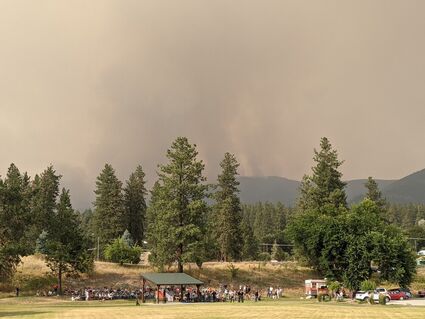



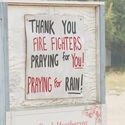
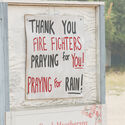

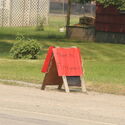
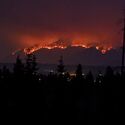
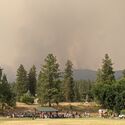
Reader Comments(0)